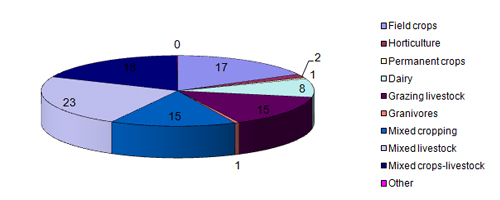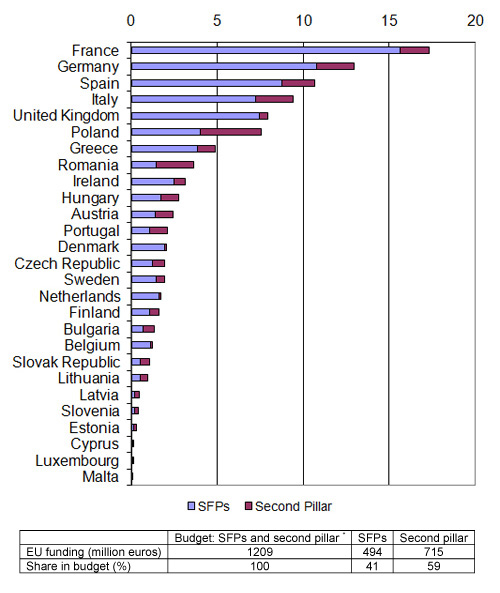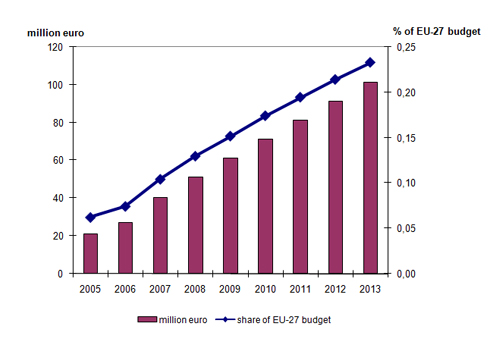Estonia
• General country description
• A. First pillar: implementation of CAP reforms (2003)
• B. Second pillar: implementation of RDP measures during 2007-2013
• C. Vision for the CAP beyond 2013: a short overview of the debate (at Member State level) on future CAP reform
• D. Literature, sources, references
• The comparative analysis provides a compact overview of CAP implementation across all 27 Member States and their visions of the future of the CAP
General country discription
Estonia |
Comparison with EU-25 |
Population, 2005 (*1,000,000): 1.4 |
0.3% of population in EU-25 |
Population density, 2003 (inh./km2): 31 |
118 in EU-25 |
GDP/capita, 2005 (PPS): 12,800 |
55% of GDP/capita in EU-25 |
Share agriculture in total employment, 2002 (%): 7 |
5% in EU-25 |
Share Utilized Agricultural Area in total land area, 2003 (%): 20 |
46% in EU-25 in 1998 |
Average farm size, 2005 (ha): 57 |
19 in EU-15 |
Number of farms, 2005 (*1000): 13.4 |
0.2% of farms in EU-25 |
Source: own calculations based on Eurostat
Distribution of farming types, 2005 (% of total)

Source: own calculations based on Eurostat
EU funding for the Single Payment Scheme (SPS)
and the second pillar, 2007-2013

* Funding according to CAP budget including Bulgaria and Romania
Sources: Agra Europe (2007); CEU (2006); EC (2007a)
A. First pillar: implementation CAP reform (2003)
A.1 Single Payment Scheme
Model
Implementation in 2009. SAPS (EC, 2007)
Coupling measures
no information
Reason for selection
no information
A.2 EU budget for Single Payment Scheme (SPS) per year (National ceiling) 2005-2013

Source: 2005: EC (2006); 2006-2013: CEU (2006) and Agra Europe (2007)
Tradability of SPS
No information
A.3 Cross-compliance: Good Agricultural and Environmental Conditions (GAEC)
Source: Cross-Compliance in Central and Eastern European Countries
Selected standards of the GAEC
Issue |
Standards |
EE |
Comment (IEEP) |
minimum level of maintenance |
avoiding the encroachment of unwanted vegetation on agricultural land |
yes |
grow crops on arable land or sow on abandoned land at least from 15-6 onwards or keep under black fallow, mechanical weed treatment on abandoned land; mow grassland and collect the hay at least once a year or graze before 31-7. |
Estonia focuses on minimum level of maintenance by keeping the land under crops or grassland.
Reason for selection of cross compliance standards
No information
A.4 Further reform of market regulations
No information
B. Second pillar: implementation of RDP measures 2007-2013
B.1 Programme level and approval
There is one national RDP. The Rural Development Committee (consisting of representatives of the 27 Member States) has approved the RDP for Estonia on 21 November 2007.
B.2 Distribution of public budget over the axes (%) 1)
axis 1: competitiveness |
axis 2: environment and land management |
axis 3: rural economy |
Axis 4: Leader |
39 |
38 |
13 |
10 |
1) Figures excluding Technical Assistance
Source: Own calculations based on Põllumajandusministeerium (2007)
B.3 Integration of Leader in axes 1, 2 and 3
Leader contributes to Axes 1 and 2.
B.4 Local Action Groups (LAGs)
It is intended to create 27 LAGs in the coming programming period, covering about 40,000 km2 (Põllumajandusministeerium, 2007).
B.5 RDP budget 2007-2013 (million euros)
total public budget |
% co-financing EAFRD1) |
EAFRD budget |
Contribution private sector |
Total costs |
National top-ups |
924.9 |
77 |
714.7 |
444.1 |
1368.9 |
0 |
1) % of co-financing may vary per axis
Source: Põllumajandusministeerium (2007)
B.6 Less Favoured Areas
Estonia has designed 350,000 ha as areas with handicaps and 38,000 ha as areas with environmental restrictions (Põllumajandusministeerium, 2007). In 2005, 40% of the Utilized Agricultural Area (UAA) (338,000 ha) was classified as Less Favoured Area (LFA) (CEU, 2005).
B.7 Drivers of RDP strategy
No information
C. Vision on the CAP beyond 2013*
No information. However, the Minister of Agriculture believes that capping of single farm payments of large farms is unfair and could cause large holdings to split up in order to avoid aid caps (Agra Europe, 2008).
D. Literature, sources, references
- Agra Europe (2007), "Threat of SFP cuts rises as NMS accede", Agra Europe Weekly, January 12
- Agra Europe (2008), "NMS urge end to historical SFP payments", Agra Europe Weekly, March 17
- Council of the European Union (CEU) (2005), Proposal for a Council Regulation on support for rural development by the European Agricultural Fund for Rural Development (EAFRD) - redefinition of intermediate less-favoured areas, Brussels, Working Party on Agricultural Structures and Rural Development, working document (7971/05), 15 April
- Council of the European Union (CEU) (2006), Council Regulation 1782/2003 (consolidated version - August 5, 2006), Annex VIII and VIIIa, Brussels
- European Commission (EC) (2006), 35th Financial Report on the European Agricultural Guidance and Guarantee Fund, Guarantee section, 2005 Financial Year, SEC(2006)1152
- European Commission (EC) (2007a), EU support for rural development 2007-2013; Pre-allocated funding under Heading 2 "Natural Resources" of the Financial Framework, Brussels:
- European Commission European Commission (EC) (2007b), Overview of the implementation of direct payments under the CAP in Member States Version November2007, EC, DG for Agriculture and Rural Development
- IREAS Institute for Structural policy (2004), Cross-Compliance in Central and Eastern European Countries
- Ministry of Agriculture of the Republic of Estonia (2006), Estonian Rural Development Strategy 2007-2013, version September 2006
- Põllumajandusministeerium (2007), Eesti maaelu arengukava 2007-2013, version 20 November 2007
